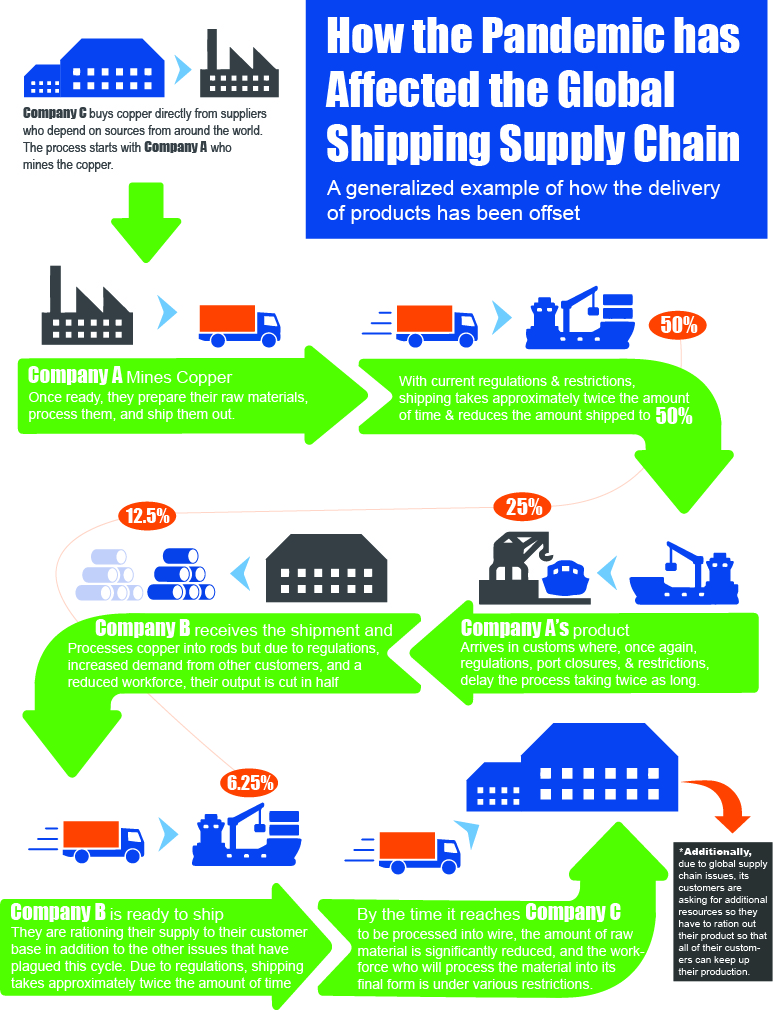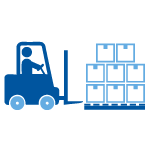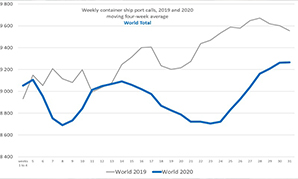How Pacer is addressing the global shipping shortage
Posted by Pacer on 2nd Aug 2021
What the world is experiencing

As the dust settles and the world attempts to return to normality, manufacturers and global shipping partners face new challenges. Over the last 18 months, we have seen a dramatic shift in our daily routines and the world at large. These changes have affected not only the way we shop but the way we receive our goods as well. Brick and mortar stores are rapidly being replaced by online retailers. According to McKinsey & Company (1), a global consulting firm, online shopping has increased approximately 15-30% across a wide range of product categories in the last year. This increased demand is only part of the global shipping shortage.
What contributed to the global shipping shortage?
 Click on the image to see a larger version.
Click on the image to see a larger version.
The truth is that a combination of factors has combined to create this strain on the global supply chain. The easiest way to explain this might be with a hypothetical situation. Suppose copper ore is mined by Company A. Due to workforce regulations surrounding the pandemic, Company A’s labor force is cut in half. So now only 50% of the normal amount of copper ore is being mined. To make matters worse as Company A ships the copper ore, it is held up in customs due to port closure or limited capacity. Now it takes twice as long for that copper ore to reach the next step. So that 50% capacity that was mined by Company A is now equal to 25% as it takes twice as long reach its destination. Company B turns the copper ore into copper rods however, they too face labor shortages and workforce regulations and are at half capacity. So now, that 25% is more like 12.5% since it takes twice as long to process due to limited staff. Now Company B is ready to ship the copper rods to us but there again, they face issues at customs due to port closure or limited capacity. Once again it takes twice as long to ship meaning that 12.5% capacity could be considered 6.25%. You can clearly see how, when applied globally across nearly every industry, this creates a major strain on the global supply chain. Take a look at the infographic to the right to see a clear example of what we mean (click on it to see a larger version).
The point of this hypothetical situation is that labor forces are reduced meaning that raw material output is reduced. This in turn means that product production is also reduced. This coupled with extended shipping times and delays combine to create the challenges we are facing today. This challenge has affected every one of our product lines in some way. As we will discuss further down, we have been going above and beyond to source materials and product wherever possible, even at our own expense. If we do not have it, you can’t get it.
How Pacer is tackling the challenge
Every challenge is a chance to improve, to learn, and to safeguard the future against similar issues. We at Pacer have been working tirelessly to maintain production and obtain products and materials to help keep our partners and customers on track.
We work closely with supply chain vendors
Strengthening our relationships with our vendors has
allowed us to solidify some products while obtaining information about the availability
of others. That information helps us to not only track down hard-to-find items
but to do so at the most reasonable price possible.
We continually
look for alternative sources
While strengthening our relationships is crucial, so is
building new ones. We have strengthened our commitment to locating needed
products by contacting new vendors and sources and building new relationships
with them. In this way, we have greater buying power and more opportunities to
find the needed materials.
 We listen to
our customers and clients
We listen to
our customers and clients
When our customers call asking about certain products, we
know just how important those products are to them. Our partners and customers need them, and we made a
commitment to offering solutions. This is why we have a renewed focus on
finding what our customers and partners need so they can continue to move
forward.
 We maintain
inventory when possible
We maintain
inventory when possible
Rather than removing inventory to make way for new
items, we are continuing to maintain stock on items we normally would not in
order to meet the needs of companies during this global shipping shortage. This way our partners can get the materials and components they need to keep their production lines moving.
 We take advantage
of process innovations
We take advantage
of process innovations
With limited materials available we have made internal
adjustments to help reduce waste and make the available materials go further.
This way we reduce strain on the supply chain and still meet our internal
standards of excellence.
 We have shifted
focus to product attainment
We have shifted
focus to product attainment
With a renewed focus on helping customers and partners,
we have devoted staff to seek out a finding product wherever possible. As
products and materials arrive at our storefront and production facilities, we
stock our shelves and online inventory quickly so that customers and partners
can get what they need.
What we can expect in the coming months

If the last year has taught us anything it is that the future is uncertain however, there is reason to be optimistic. All signs are showing a slow but steady recovery so we can expect some alleviation. Many experts suggest that the global shipping shortage could last well into 2022 with some speculating that the issue will not be resolved until beyond that point.
The bottom line is that regardless of the time it takes for the global supply chains to return to normal, Pacer will be working endlessly to get the materials and products needed to keep our partners and customers going and our production lines running. We remain steadfast in our commitment to being your electrical solutions provider.
References
(1)
https://www.weforum.org/agenda/2021/07/global-consumer-behaviour-trends-online-shopping/
